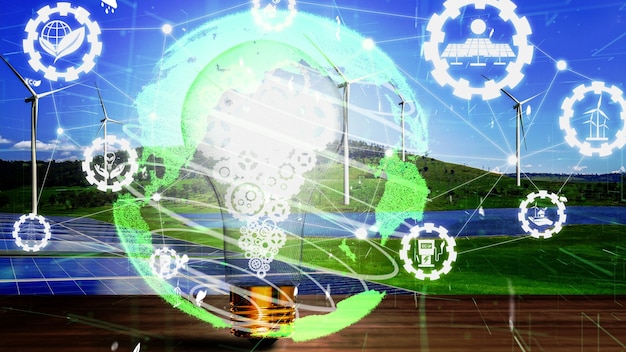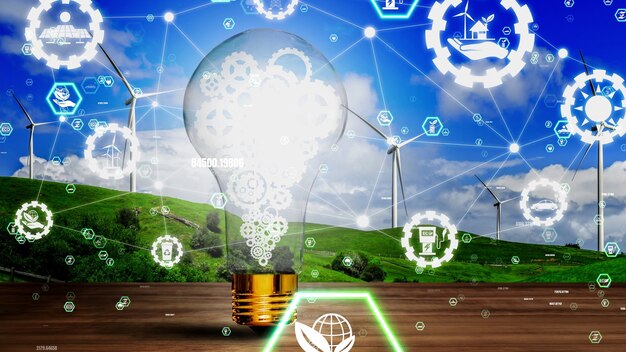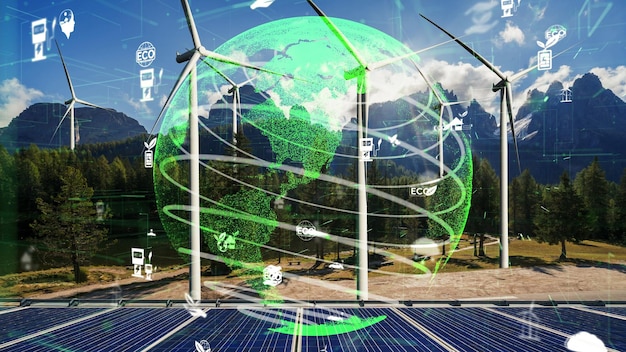Quick Read
The Big Tech Clean Energy Crunch: How the Demand for Renewable Energy is Outpacing Supply
Big Tech‘s
insatiable appetite for renewable energy
is pushing the boundaries of what’s currently available and sustainable. With data centers and
servers
consuming more power each year, tech companies are racing against the clock to source clean energy at an unprecedented rate. The
demand-supply gap
is growing, and the repercussions could be far-reaching.
Renewable Energy’s Role in Tech
Renewable energy is crucial for the tech industry. It powers data centers and cools servers, making it essential for maintaining a reliable digital infrastructure. In fact,
has pledged to run on 100% renewable energy by 2030. Amazon and Microsoft have similar goals, with the latter committing to be carbon negative by 2030.
The Supply Crunch
However, the current renewable energy supply cannot keep up with the industry’s
ever-growing demand
. Solar and wind power, the primary renewable sources for Big Tech, are intermittent. This means they generate energy only when conditions allow, making them an inconsistent source of power for the tech industry’s constant electricity needs.
The Impact
The renewable energy crunch could result in several consequences. One possibility is a reliability issue, as tech companies might be forced to rely more on fossil fuels to meet their energy demands. Another concern is the
potential for increased carbon emissions
, as the tech industry might have to turn to traditional power sources during energy shortages. Lastly, there is a financial impact for these companies as they might have to pay more for renewable energy or invest in their own sources to ensure a steady supply.
Solutions and the Road Ahead
To address this issue, tech companies are exploring various solutions. These include investing in their own renewable energy infrastructure, buying renewable energy from the grid during periods of surplus, and collaborating with utility companies to increase renewable energy production.
In conclusion, the tech industry’s demand for clean energy
, particularly from renewable sources like wind and solar, is growing at a much faster rate than their availability. This
renewable energy crunch
could lead to reliability issues, increased carbon emissions, and financial implications for tech companies. To overcome these challenges, companies are exploring innovative solutions, collaborating with utility providers, and investing in their own renewable energy infrastructure. The road ahead is not easy, but with determination and collaboration, the tech industry can continue its transition to a cleaner, more sustainable future.

Exploring the Clean Energy Crunch in the Tech Industry
Big Tech companies have been increasingly embracing renewable energy as a key component of their sustainability strategies. With Google, Microsoft, Amazon, and other tech giants pledging to go carbon-neutral or even carbon-negative, the demand for renewable energy is
skyrocketing
. However, this trend comes with a significant challenge: the
clean energy crunch
. Renewable energy sources, such as wind and solar power, are becoming increasingly scarce due to their intermittent nature and geographical limitations. As a result, Big Tech‘s insatiable appetite for renewable energy is
outpacing the available supply
, creating a precarious situation for these companies looking to meet their ambitious climate goals.
The clean energy crunch is not a new phenomenon, but the urgency and scale of it have heightened as more tech companies make commitments to transition away from fossil fuels. According to a report by BloombergNEF, renewable energy capacity additions will need to more than double each year from 2023 to 2030 to meet net-zero targets. However, with current policies and technologies, it is unlikely that this rate of growth can be sustained, leading to a potential
energy gap
. This gap could result in increased reliance on fossil fuels, undermining the very goals these companies are trying to achieve.
To address this issue, Big Tech companies are exploring various solutions. Some are investing in renewable energy infrastructure and storage technologies like batteries to mitigate the intermittency of solar and wind power. Others are pursuing partnerships with utilities and governments to secure long-term renewable energy contracts. Additionally, some companies are considering offsetting their energy use through carbon credits or purchasing renewable energy certificates. However, the long-term sustainability and ethical implications of these solutions remain to be seen.
As the clean energy crunch continues to evolve, it is essential that Big Tech companies and policymakers work together to find sustainable solutions. The stakes are high: failing to address this issue could result in a return to business-as-usual reliance on fossil fuels, or even worse, a shift towards riskier and more environmentally damaging energy sources. By collaborating on innovative solutions that balance the demands of
growing renewable energy adoption
and the realities of an increasingly scarce clean energy supply, we can ensure a sustainable future for our planet and our industries.

Background: The Rise of Big Tech’s Renewable Energy Demand
Environmental Concerns: With the growing awareness of climate change and its impact on the planet, tech companies have begun to address their carbon footprint in a significant way. The environmental concerns surrounding traditional energy sources have led these corporations to switch to renewable energy. This shift not only helps in reducing greenhouse gas emissions but also enhances their corporate social responsibility image.
Reduction in Carbon Footprint:
The technology sector is one of the largest contributors to global carbon emissions, primarily due to energy-intensive activities like data centers and cloud computing facilities. By transitioning to renewable energy sources, tech companies can make a substantial contribution towards reducing their carbon footprint. Renewable energy sources like wind, solar, and hydroelectric power generate electricity without the emission of greenhouse gases. This shift is essential as the tech industry continues to expand and its energy demands increase.
Improvement of Corporate Social Responsibility Image:
In an era where consumers are increasingly conscious of the environmental impact of their choices, companies that adopt renewable energy are perceived more favorably. A renewable energy commitment is an effective way for tech companies to improve their corporate social responsibility image and attract consumers who value sustainability.
Scale of Renewable Energy Demand by Big Tech Companies:
Big Tech‘s demand for renewable energy is immense, with data centers and cloud computing facilities accounting for a significant portion of this demand. These facilities require large amounts of electricity to maintain their operations 24/7. Additionally, tech companies have numerous manufacturing plants and offices that consume substantial energy. To meet this demand, tech giants like Apple, Microsoft, and Google have made commitments to power their operations entirely with renewable energy sources.
Data Centers and Cloud Computing Facilities:
Data centers and cloud computing facilities are the most energy-intensive operations in the tech industry. These facilities consume approximately 2% of the world’s electricity, according to recent estimates. Renewable energy is an essential component of any sustainability strategy for these companies as they aim to power their data centers and cloud services with clean energy.
Manufacturing Plants and Offices:
Tech companies also have numerous manufacturing plants and offices that consume substantial energy. To meet their energy needs, many tech companies are turning to renewable energy sources. For instance, Apple has committed to using 100% renewable energy for all of its business operations worldwide by 2030. This includes not only its data centers and offices but also the manufacturing facilities where iPhones, Macs, and other devices are produced.

I The Clean Energy Crunch: Supply Struggles to Keep Up with Demand
In today’s world, the transition towards renewable energy sources is no longer a distant dream but an imminent reality. Solar, wind, and hydropower are at the forefront of this revolution, accounting for a significant proportion of the world’s electricity production. However, as the world shifts towards renewables to address
global energy consumption trends
, challenges in meeting the demands of major tech companies are becoming increasingly apparent.
Description of the current state of renewable energy production and consumption:
The renewable sector has seen remarkable growth in recent years. According to the International Energy Agency, renewables accounted for over 80% of new power capacity additions in 2019. Solar photovoltaics and wind energy have been the primary contributors to this growth. In 2020, solar and wind combined generated over 1,300 TWh of electricity, representing a 20% increase from the previous year. However, despite these strides, renewable energy still accounts for only around 30% of global electricity generation.
Global energy consumption trends:
Worldwide energy demand continues to rise, with the International Energy Agency projecting a 1% annual increase between now and 2050. The majority of this growth is expected to come from emerging economies, particularly in Asia. As a result, the need for reliable and sustainable energy sources is more pressing than ever.
Analysis of the challenges in meeting Big Tech’s renewable energy demands:
Intermittency and variability of renewable energy sources:
One of the most significant challenges in meeting the demands of tech giants like Google, Microsoft, and Amazon is the intermittency and variability of renewable energy sources. Solar and wind power are dependent on weather conditions and cannot be generated consistently. This inconsistency makes it difficult to supply the steady electricity needed for tech companies’ massive data centers and other operations.
Infrastructure development and expansion requirements:
To address the inconsistency of renewable energy sources, significant investments in infrastructure development and expansion are required. This includes building large solar farms, wind turbines, and battery storage facilities. These projects can take years to complete, making it challenging for tech companies to meet their immediate energy needs.
Impact on energy prices: Increasing demand leading to higher costs for renewable energy
As the demand for renewable energy increases, so do the prices. Tech companies with large energy requirements face significant financial risks as they try to secure enough clean energy to power their operations. The high cost of renewable energy can lead to increased costs for consumers, making it essential for governments and corporations to collaborate on finding solutions to make clean energy more affordable and accessible.

Strategies for Bridging the Clean Energy Gap
A. One effective strategy for bridging the clean energy gap is collaboration between Big Tech companies and utility firms. This partnership can lead to significant improvements in grid infrastructure and the seamless integration of renewable energy sources. By working together, these entities can develop advanced technologies to address challenges such as intermittency and variability in renewable energy production. For instance, Big Tech companies can leverage their expertise in data analysis and AI to optimize grid operations and predict power demand, while utility companies bring their knowledge of infrastructure management and electrical distribution.
Energy storage solutions
Another crucial element in the transition to a clean energy future is the advancement of energy storage solutions. With the increasing adoption of renewable energy sources, there is a pressing need to store excess energy generated during peak production times for use during periods of high demand. This is where battery technology comes in, offering significant potential to address the energy storage challenge. Innovations in battery chemistry and design have led to a steady decrease in costs and an increase in efficiency. As a result, large-scale battery installations are becoming more economically viable and can help ensure a stable energy supply while maximizing the use of renewable energy.
Renewable energy purchasing agreements
A third strategy gaining popularity among corporations is the adoption of renewable energy purchasing agreements. Through Power Purchase Agreements (PPAs) and Renewable Energy Certificates (RECs), corporations can buy renewable energy directly from producers. PPAs allow companies to purchase electricity generated by renewable energy sources at a fixed price for a specified period. RECs, on the other hand, represent the environmental attributes of renewable energy production and help support the development of new renewable projects. By investing in renewable energy through these agreements, corporations can secure their energy needs while reducing their carbon footprint and contributing to the growth of the clean energy sector.
Innovative renewable energy projects
Lastly, corporations are increasingly investing in innovative renewable energy projects to secure their long-term energy needs. From wind and solar farms to geothermal and hydroelectric power plants, large-scale renewable energy initiatives offer a sustainable alternative to traditional fossil fuel sources. By taking an active role in the development and operation of these projects, corporations can not only reduce their carbon emissions but also build a more resilient energy portfolio. Moreover, collaborating with other industry leaders and governments on these projects can help create a shared vision for a cleaner, greener future and drive further advancements in renewable energy technology.

Conclusion
As we’ve explored in this article, the clean energy crunch is a pressing issue that threatens to hinder the adoption of renewable energy sources by Big Tech companies. With the increasing demand for data centers and servers, the electrical consumption of these companies is projected to exceed the global electricity production by 2030, according to a report by the International Energy Agency (IEA). This trend not only puts a strain on the electrical grid but also contributes significantly to carbon emissions.
Recap of the Issue and Its Implications
The clean energy crunch arises due to the intermittency and inconsistency of renewable energy sources, such as solar and wind power. The variability of these sources makes it challenging for Big Tech companies to rely solely on them, leading to a heavy reliance on fossil fuels and resulting in increased carbon emissions. This issue is not only detrimental to the environment but also poses economic risks, as energy prices continue to rise, and regulatory pressures on companies to reduce their carbon footprint intensify.
Potential Solutions
Collaboration and Partnerships
One way to address the clean energy crunch is through collaboration and partnerships between Big Tech companies, governments, and renewable energy providers. These collaborations can involve sharing resources, such as data centers, and developing joint initiatives to address the clean energy challenge. For instance, Google, Microsoft, and Facebook have formed the Clean Energy Buyers Association to collectively advocate for renewable energy policies and investments.
Technological Advancements
Another potential solution lies in technological advancements aimed at improving energy storage capacity and efficiency. This includes the development of advanced battery technologies, such as lithium-ion batteries with longer life cycles, and research into alternative energy storage solutions like flow batteries and pumped hydroelectric systems. Additionally, advancements in artificial intelligence (AI) and machine learning can be utilized to optimize energy usage patterns and predict demand, ultimately reducing the reliance on fossil fuels.
Call to Action
To ensure a sustainable energy future, it is crucial that governments, corporations, and the public take action to address the clean energy crunch. This can be achieved by increasing investments in renewable energy infrastructure and research, implementing energy efficiency measures, and supporting policies that incentivize the adoption of clean energy. Additionally, corporations can collaborate to share resources and expertise, while governments can establish regulations and standards to encourage a transition towards renewable energy sources. By working together, we can overcome the clean energy crunch and pave the way for a more sustainable future.
The Time is Now
As the demand for clean energy continues to grow, it is essential that we act now to mitigate the challenges posed by the clean energy crunch. The future of our planet and the sustainability of our technological advancements depend on our ability to make a swift and successful transition towards renewable energy sources. By embracing collaboration, investing in innovation, and taking action as individuals, corporations, and governments, we can create a cleaner, more efficient, and more sustainable world for future generations.
